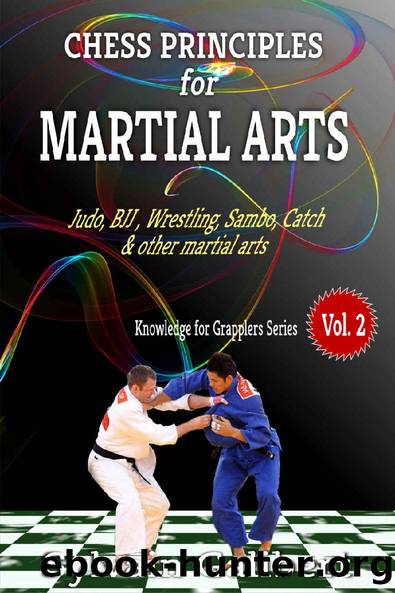Chess principles for Martial Arts: Chess Tactics and Strategies for Judo, BJJ, Boxing and other Martial Arts (Knowledge for Martial Arts Book 2) by Sylvain Galibert

Author:Sylvain Galibert [Galibert, Sylvain]
Language: eng
Format: epub
Published: 2018-10-18T00:00:00+00:00
Threaten small to take big
Yeah, the corollary of the previous principle: people pay close attention to the big threats and to moves they donât understand.
If you are aiming only for the king, your attack is obvious. On the other end, if your bishop is also targeting a weak pawn, your opponent may overlook that it would allow your knight to come in close to the king.
If a move has apparently no purpose, your opponent may wonder why youâre making it and search until he finds the threat. However, if there is a visible threat, like taking a pawn, or exchanging a minor piece, your opponent may very well protect the piece under attack and miss completely the bigger picture.
Youâre fighting for a sleeve grip (Judo), pulling, pushing, etc. and as the opponent pulls back to defend the grip, you step in with O Soto Gari (Judo throw â check it out on YouTube). Since his attention was on the sleeve, he's doesnât see the O Soto coming.
Youâre pumping a weak jab at your opponent âto keep distanceâ and when he tries to crowd you, you fire a big right to the jaw.
If your opponent has no explanation for your move, heâll be on his guard. However, if the preparatory move appears to be a weak attack or aimed at a target your opponent doesnât worry much about, your chances of scoring big increase a lot.
Download
This site does not store any files on its server. We only index and link to content provided by other sites. Please contact the content providers to delete copyright contents if any and email us, we'll remove relevant links or contents immediately.
The Infinite Retina by Robert Scoble Irena Cronin(6070)
Harry Potter and the Cursed Child: The Journey by Harry Potter Theatrical Productions(4428)
The Sports Rules Book by Human Kinetics(4272)
Molly's Game: From Hollywood's Elite to Wall Street's Billionaire Boys Club, My High-Stakes Adventure in the World of Underground Poker by Molly Bloom(3472)
A Knight of the Seven Kingdoms by George R R Martin(3174)
Quidditch Through the Ages by J.K. Rowling(3052)
How To by Randall Munroe(3016)
Flowers For Algernon by Daniel Keyes(2929)
Quidditch Through the Ages by J K Rowling & Kennilworthy Whisp(2921)
Quidditch Through the Ages by Kennilworthy Whisp by J.K. Rowling(2807)
Stacked Decks by The Rotenberg Collection(2796)
Quidditch through the Ages by J. K. Rowling(2758)
Quidditch Through The Ages by J. K. Rowling(2720)
776 Stupidest Things Ever Said by Ross Petras(2678)
Ready Player One: A Novel by Ernest Cline(2637)
What If?: Serious Scientific Answers to Absurd Hypothetical Questions by Randall Munroe(2626)
Beautiful Oblivion by Jamie McGuire(2556)
The Book of Questions: Revised and Updated by Gregory Stock Ph.d(2502)
Champions of Illusion by Susana Martinez-Conde & Stephen Macknik(2403)
